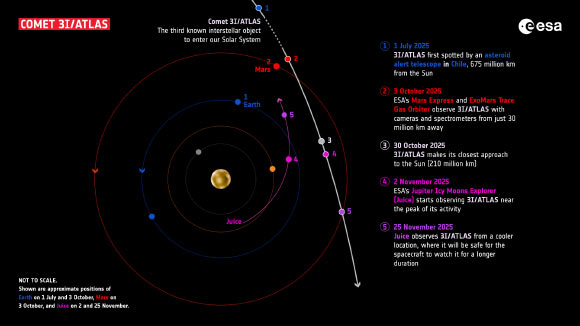At its closest approach to Mars on October 3, 2025, 3I/ATLAS was 30 million km from ESA's ExoMars Trace Gas Orbiter (TGO).
This image of interstellar comet 3I/ATLAS was captured on October 3, 2025 by the CaSSIS instrument on board ESA's Trace Gas Orbiter. Image credit: ESA/TGO/CaSSIS.
TGO acquired the new 3I/ATLAS images using its Color and Stereoscopic Surface Imaging System (CaSSIS).
“This was a very difficult observation for the instrument,” said Dr Nick Thomas, Principal Investigator of the CaSSIS instrument at ESA.
“3I/ATLAS is a slightly fuzzy white dot moving down towards the center of the image.”
“This point is the center of the comet, including its icy rocky core and the surrounding coma.”
“CaSSIS was unable to distinguish a nucleus from a coma because 3I/ATLAS was too far away.”
“The angular resolution of the CaSSIS camera is 11.36 microradians (equivalent to 2.34 arcseconds) per pixel,” said Harvard University Professor Avi Loeb.
“At the shortest distance from 3I/ATLAS, which is about 30 million km, this resolution corresponds to 340 km.”
“The size of this pixel is 1-2 orders of magnitude larger than the expected 3I/ATLAS core diameter, which ranges from a minimum of 5 km to a maximum diameter of 46 km.”
“Part of this expansion is visible in the CaSSIS images,” he said.
“The passage of 3I/ATLAS over the Martian sky is observed from Mars orbiters almost perpendicular to the 3I/ATLAS-Sun axis, allowing a side view of the scale of the glow expansion around 3I/ATLAS.”
“The width of the bright light around 3I/ATLAS in the CaSSIS image is approximately twice the diameter of the bright stars that serve as background point sources in the same image.”
“This length corresponds to a scale of 680 km, which is an order of magnitude smaller than the width displayed on Hubble image“
“It is therefore clear that CaSSIS can only detect the brightest region around the 3I/ATLAS core, while missing the lower surface brightness envelope that is visible in the Hubble image.”

From 2 to 25 November 2025, ESA's Jupiter Icy Moon Explorer will observe 3I/ATLAS using a variety of instruments. Image credit: ESA.
“While our Mars orbiters continue to make impressive contributions to Mars science, it is always exciting to see how they respond to unexpected situations like this,” said Dr Colin Wilson, Project Scientist for Mars Express and ExoMars at ESA.
“I look forward to seeing what the data reveals after further analysis.”
Next month, ESA researchers will observe 3I/ATLAS with the Jupiter Icy Moons Explorer (Juice).
Although Juice will be further away from 3I/ATLAS than Mars orbiters were last week, the spacecraft will see the comet just after its closest approach to the Sun, meaning it will be in a more active state.
“We do not expect to have observations of Jus until February 2026,” they said.








